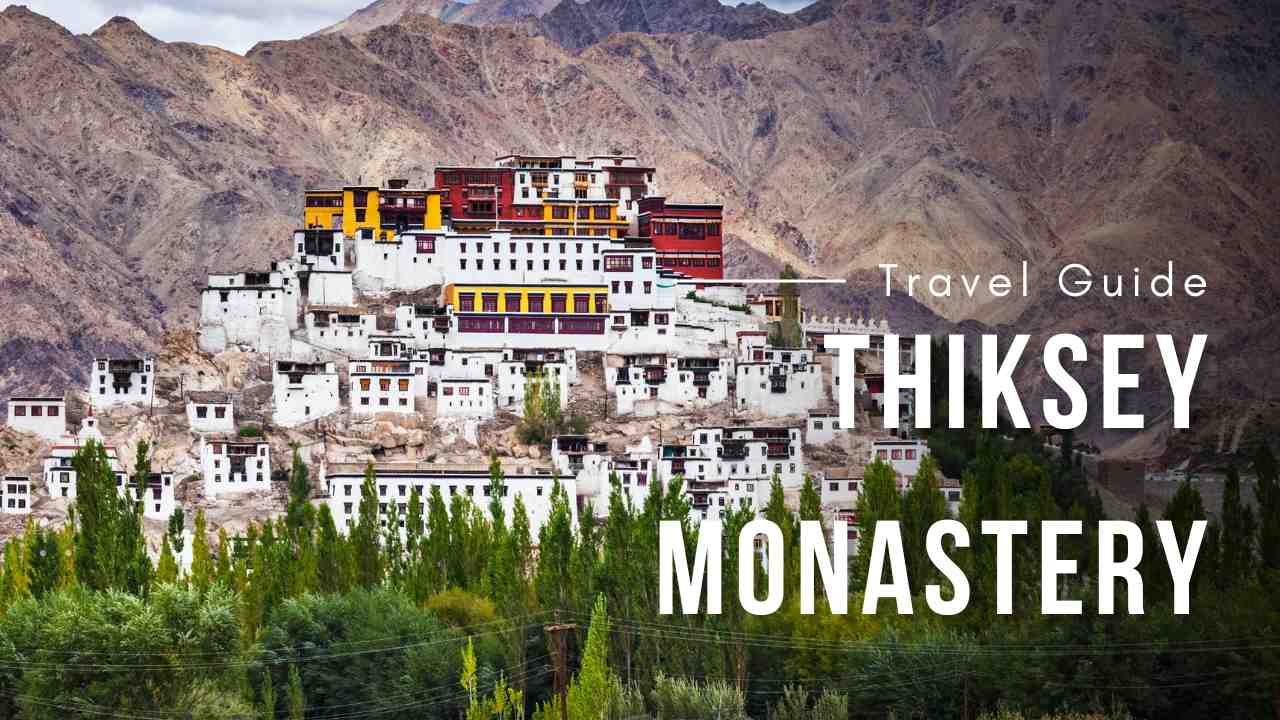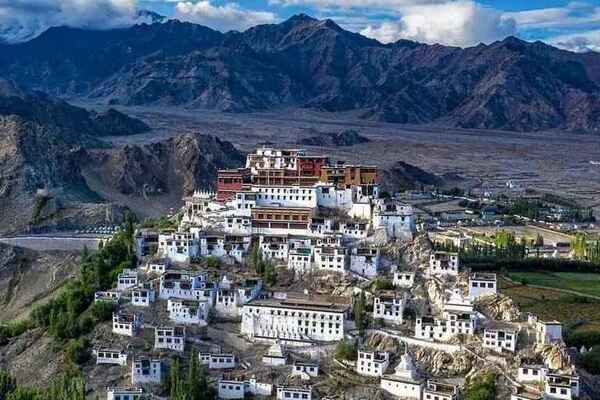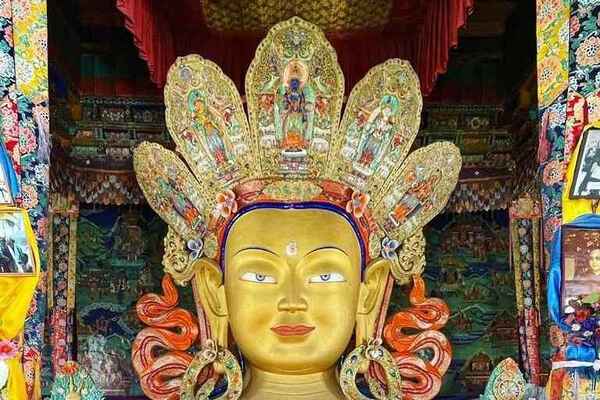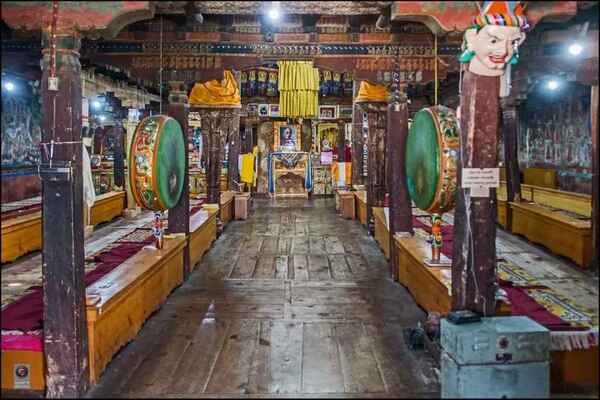
Thiksey Monastery is a major Buddhist monastic complex in the mesmerizing landscapes of Ladakh, Northern India, and is a tribute to the region’s rich spiritual tradition. Thiksey Monastery, perched dramatically on a hilltop, is commonly referred to as “Mini Potala” due to its striking resemblance to Tibet’s famed Potala Palace. Its architecture, with white-washed walls and golden spires, stands out against the harsh Himalayan landscape, making it a visual marvel.
Thiksey Monastery dates back to the 15th century and is linked with the Gelugpa branch of Tibetan Buddhism, also known as the Yellow Hat sect. This spiritual institution, which houses a significant collection of scriptures, stupas, and exquisite thangka paintings, is critical in preserving and transmitting Buddhist teachings. It serves as a center of worship for the local population and a tourist destination for those interested in Ladakh’s spiritual and cultural legacy.
The yearly Gustor Festival, which attracts pilgrims and guests from all over the world, is one of the most captivating characteristics of Thiksey Monastery. Monks conduct elaborate masked dances and ceremonies throughout this spectacular event, bringing a colorful layer to the spiritual experience. Thiksey Monastery, where old traditions meet beautiful surroundings, is a must-see for those seeking a deeper understanding of Ladakh’s distinctive cultural tapestry and spiritual foundations.
This monastery’s history dates back to the early 15th century when Je Tsongkhapa, the famed founder of the Gelug School, or “Yellow Hats,” set out to promote Buddhism. Six of his faithful disciples were blessed and sent to rural Tibet. They included Jangsem Sherap Zangpo, who was given a valuable Amitayus statue with his blood and bone powder. His objective was to spread Buddhism with Ladakh’s King’s help.
The revered statue moved the King in the tranquil near Shey. This meeting caused the King to ask his minister to help Sherab Zangpo find a Gelug monastery in Ladakh. In 1433, Zangpo founded Lhakhang Serpo, “Yellow Temple,” a small village monastery in Stagmo, north of the Indus River. Some of Sherab Zangpo’s students became revered individuals in the region as the Gelug order rose to prominence despite initial hurdles.
While performing religious rites near the Yellow Temple, Sherab, and Palden Zangpo made an amazing discovery. Two crows grabbed a ceremonial plate with torma offerings and carefully placed it on a stone on the opposite side of a hill where Thiksey Monastery currently sits. A heavenly indication, this astonishing incident guided them to build the monastery at this precious spot.

Thiksey Monastery, a new monastery on a venerated hill above Stagmo hamlet, was close to Stagmo. It was likely erected on the site of an earlier Kadam business or as a daughter home of Stakmo’s modest chapel, 7 kilometres north. Rinchen Zangpo, a famous character in Thiksey, contributed to the region’s spiritual legacy by building Lakhang Nyerma, a Dorje Chenmo temple. Although only ruins exist, the site’s history is preserved.
In Ladakh, Thiksey Monastery became second only to Hemis. Ten monasteries in the region, including Diskit, Spituk, Likir, and Stok, were under its administration. The monastery controlled 1,327 acres and 25 communities. Thiksey Monastery’s history was changed in the late 18th century when the lama of Hanle Monastery ordered his elder son to ascend the Ladakhi throne. At the same time, other princes became lamas at Thiksey and Spituk.
Thiksey Monastery’s architectural splendor is a tribute to Ladakh’s rich cultural and spiritual history. This religious complex, known as the “Mini Potala” for its resemblance to Tibet’s famed Potala Palace, is a stunning example of Himalayan architecture. Let’s take a look at the architectural highlights that make Thiksey Monastery such a visual treat:
Exterior
Perched dramatically on a hilltop, Thiksey Monastery’s exterior is a striking sight against the rugged backdrop of Ladakh. Its whitewashed walls, adorned with intricate details and artistic motifs, exude a sense of serenity and grandeur. The golden spires and pagodas rise gracefully into the sky, glistening in the sunlight. Its building is well-spaced and has twenty stories placed in ascending order of importance, from the residential units at the foot of the hill to the monasteries and posting (official house) of the chief lama at the top.
Buddha Statue
The large Maitreya Buddha statue is one of Thiksey Monastery’s most recognizable features. This beautiful statue of the future Buddha soars to a height of almost 49 feet, covering two flooders of the building is a sight to behold. The meticulously crafted statue represents compassion and enlightenment. Its tranquil appearance and immense size make it the centre of attention inside the monastery complex, luring pilgrims and visitors to experience its magnificence.

Tara Temple
The Tara Temple is a beautiful piece of architecture hidden away on the monastery’s grounds. This temple is dedicated to the goddess Tara, with 21 beautiful paintings and statues of her in all her forms. Each of these forms shows a different part of compassion and protection.
Assembly Hall
Murals of the Tibetan calendar with the Bhavacakra (Wheel of Life) are depicted on a wall at the entrance to the assembly hall or major prayer hall. The emblem motifs of a snake, a bird, and a pig on this wheel represent ignorance, attachment, and aversion. The objective of this depiction is to remind us that these earthly bonds must be overcome to achieve enlightenment and avoid the cycle of death and rebirth.

Many handmade and painted books are in the main prayer room next to this wall. Behind this prayer hall is the small inner shrine of Gautama Buddha, where Majur and Maitreya, two bodhisattvas, stand on either side. There is also a picture of the Thousand-armed Avalokitevara with Padmasambhava in the gathering hall. In the middle of the meeting hall is a seat for the Dalai Lama. To the right is a seat for the head lama, and to the left is a picture of another god.
Lamokhang temple
The Lamokhang temple is on the top floor of the monastery. It holds many books of scripture, including Kangyur and Stangyur. Men are the only ones who can go on this floor. The big stupas and mani walls are at the front of the temple. A small room on top of the temple is only used for educating boys from the nearby towns. Some of these boys are chosen to become lamas. The lama of the temple lives on the top floor, which is also his official home.
Ladakh Kushok Bakula Rimpochee Airport, Leh, is the nearest airport to Thiksey Monastery, approximately 20 km. Many domestic airlines operate flights to Leh from major Indian cities like Delhi, Mumbai, and Srinagar.
After reaching Leh by Air, acclimatise for a day and visit the Gompa in the following ways.
You may click here to learn more about how to get acclimatised in Leh.
The Gompa can be visited by hiring a car from the Local Taxi Union or via Road Expeditions.
You can hire a local bike from Leh and take the Manali Leh Highway to reach the Monastery.
The best time to visit Thiksey Monastery is between May and October, during the warmer months when Ladakh’s weather is at its best. The roads leading to Ladakh remain open throughout this period, giving it a great time to visit this fascinating region.
A few essential pieces of information when you are planning a visit to the monastery in Nubra Valley.
The monastery can be visited from May to October during this time weather is warmer and roads are open.
The entry ticket for the Monastery is Rs 30 Per Person for both Indian and foreign nations.
The Thiksey monastery is open from 6 a.m. to 7 p.m. Please feel free to contact the office at 01982 267 005.
The Monastery is just 20 km from Leh town.
The monastery is located at Situated at an altitude of 11,800 ft (3600 meters).
Airtel, Jio, and BNSL Postpaid mobile network work here in Thiksey.
The monastery is located about 20km from Leh city and can be combined in either of the itineraries of your choice based on your tour.
Visit Thiskey Monastery in Local Sightseeing
Visit Thiksey Monastery with Pangong Lake
NOTE: Please start from Pangong by 9:00 AM to complete the tour.
The following are a few known places to stay near the Thiksey Monastery.
However, we recommend you stay in Leh as the monastery is just 20km distance and one can have more options of Guest houses, Budget hotels, Luxury Hotels, and Resorts.